News | METRANS, PSR, USC ITE host Soibelman at Infrastructure Knowledge Networks Webinar
Stop the VideoNews

METRANS, PSR, USC ITE host Soibelman at Infrastructure Knowledge Networks Webinar
Tuesday, October 27, 2020
by Hayley Rundle, USC, Masters of Urban Planning 2022
On October 15, METRANS and the Pacific Southwest University Transportation Center (PSR), along with special partners, University of Southern California Institute of Transportation Engineers Student Chapter (USC ITE), presented their research webinar of the Fall 2020 webinar series. USC ITE is a student group of engineers, planners, and thinkers who aim to reimagine transportation systems, and they graciously served as cohosts for this seminar.
At the webinar, titled “Knowledge Networks for Infrastructure Systems: Bridges as Case Studies,” Dr. Lucio Soibelman showcased his ongoing research on the subject. Soibelman is Fred Champion Estate Chair in Engineering, Professor of Civil and Environmental Engineering and Spatial Sciences, and Chair of the Sonny Astani Department of Civil and Environmental Engineering, Viterbi School of Engineering, USC.
“Professor Soibelman is leading an impressive and comprehensive research project aimed at developing better ways to manage transportation infrastructure,” noted METRANS and PSR Director Dr. Genevieve Giuliano, “and his strategy to integrate many different data sources and models demonstrates the value of a multidisciplinary approach to solving complex problems.”
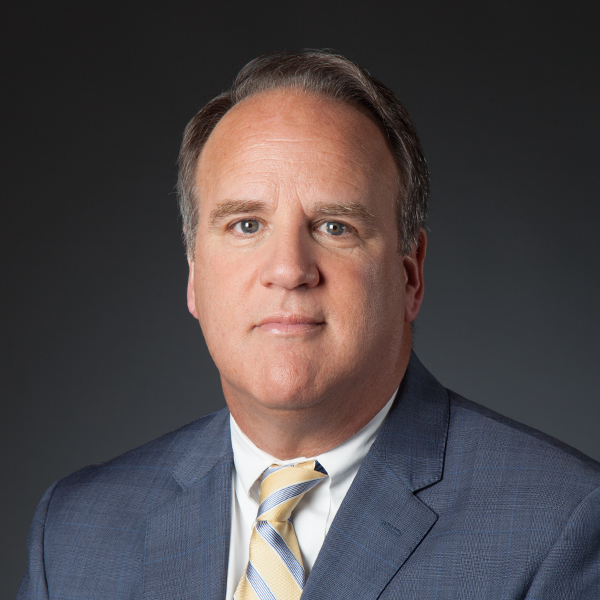
Dr. Lucio Soibelman
The webinar garnered a large virtual audience, with attendance from transportation enthusiasts across the nation, including public and private sector transportation professionals, faculty, researchers, and students in varied fields and at all levels of study. The session began with a formal presentation and then moved to the audience’s questions.
Soibelman introduced himself by specifying his research interests and describing himself as a “data guy,” having worked with big data before it was called “big data.” He shared that his research interests lie in smart infrastructure and in using data collected from said smart infrastructure to better manage infrastructure as a whole. According to Soibelman, we are in the midst of the 4th industrial revolution, and new digital technologies have allowed us to blur the lines between the physical and digital world. Because of these digital technologies, we have developed tools that allow for more efficient and effective state awareness and decision making to manage buildings and infrastructure systems. Artificial Intelligence (AI) plays a large role in creating these technologies, becoming increasingly present as we progress through the 4th industrial revolution. Soibelman suspects many jobs will disappear under the rising tide of technology.
To expand on discussion of AI and other relevant technology, Soibelman introduced Responder, a robot developed by RedZone Robotics. RedZone Robotics offers complete solutions to the need to gather and assess essential information for wastewater systems managements by using specialized robots. The Responder robot was placed in sewer pipes to assess the pipe infrastructure and document any leaks, cracks, or other problems with the sewer pipe. Solo, an autonomous robot which succeeded Responder, s capable of driving itself through sewer pipes to assess pipe infrastructure, relying on a battery that lasts an upwards of eight hours. Solo’s data was used to create maps that pinpointed which sewer pipes had defects and where they were located in the pipe system.
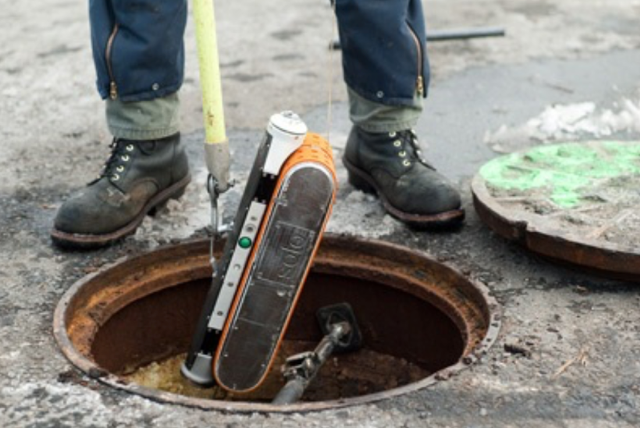
The autonomous Solo robot used to photograph the condition of sewer pipes.
Soibelman also discussed a project that he worked on for the Department of Energy. For this Project, and with a team, he examined the vulnerability of electricity production using knowledge management and visualization. After Hurricane Katrina struck New Orleans in 2005, the interdependencies of the energy and transportation systems were exposed. Hurricane Katrina destroyed the Port of New Orleans, effectively rendering it out of commission, and coal could no longer be transported to Florida for energy production. To combat problems like this in the future, Soibelman and his team developed a data warehouse that uses non-geographical and geographical data to predict the paths of hurricanes and the impact that each hurricane might have on energy production. This system predicts (and helps staff prevent) vulnerabilities in the impacted energy and transportation systems.
All of the above initiatives lead Soibelman to where he is today: developing a civil infrastructure systems open knowledge network, or CIS-OKN for short. Soibelman has received funding from the National Science Foundation (NSF) and additional support from METRANS. He describes open knowledge networks as a big data warehouse, which is a database that stores data from smart infrastructure – mostly bridges. The open knowledge network includes multiple types of data, including textual data, image data, sensor data, and inventory data. The purpose of the CIS-OKN is to create integrated representation, access, and analysis of the planning, design, construction, and operation of data of our infrastructure systems, from multiple sources and in a heterogeneous format. Through the CIS-OKN, we can fully harness these data to enable safe, efficient, and cost-effective construction, operation and maintenance of our infrastructure. In collaboration with various organizations, including Caltrans, METRANS, Purdue University, and University of Illinois, Soibelman and his team developed the CIS-OKN via a participatory design approach to better understand (and respond quickly to) the pain points, needs, and perspectives of Departments of Transportation (DOTs) and other transportation agencies, stakeholders, and researchers.
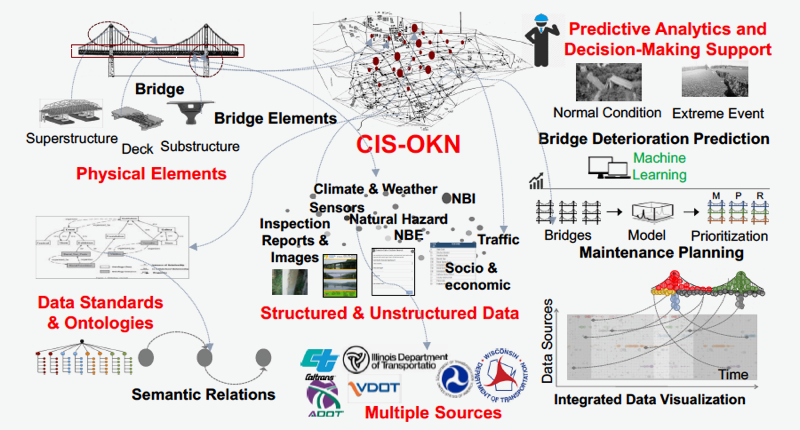
A visual of the CIS-OKN's purpose and applications.
Use cases of the CIS-OKN include condition assessment and deterioration prediction, public safety and socioeconomic impact analyses, and support for operation and maintenance decision. The CIS-OKN aids in answering vital questions: what is our infrastructure’s current and future physical condition? To what extent are the public’s safety and accessibility, and the economy affected by the condition of this infrastructure? What are the consequences of infrastructure failure?
Soibelman explained that a leading motivation in creating the CIS-OKN is to take on urban resilience change, specifically transportation since it is a vulnerable yet significant lifeline. Mobility is a functional need in the immediate aftermath of and the recovery from a disaster. Any disturbance to transportation, in the event of disaster, imposes momentous burdens on other lifelines.
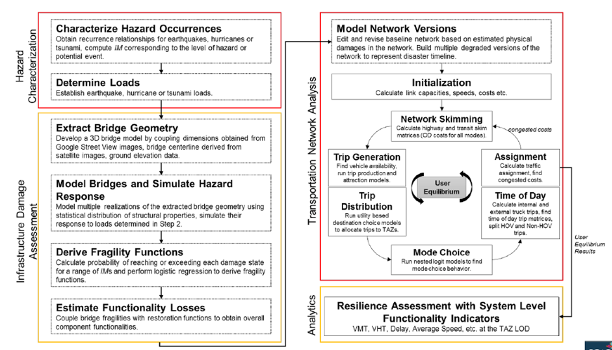
A comprehensive assessment of transportation resilience in metropolitan areas.
Soibelman also detailed a Palos Verdes case study, where the CIS-OKN assessed the predicted impacts of a potential earthquake. The case study simulated a 7.3 magnitude earthquake caused by a rupture of the Palos Verdes connected fault system. The predicted impacts were shocking: 147 bridges would be forced to close, resulting in approximately 850,000 additional person-hours spent in traffic per day in the region. The Ports of Long Beach and Los Angeles would also be disrupted, impacting import and export flows through the port complex, causing negative GDP impacts. Because of bridge closures, including freeway overpass bridges, truck travel would increase in areas adjacent to the freeway. The region would experience huge social impacts since freeways often pass through the lowest income areas – collapsed or closed freeways means that increased truck travel would occur directly in these low-income neighborhoods (as opposed to on the freeways, right next to these neighborhoods). This could lead to worsened air quality, at least temporarily, and an increased in health risks associated with air pollution.
The Palos Verdes case study required collaboration with Caltrans, who shared their data and information with Soibelman and his project team to allow for greater data stores. This combined data aided staff in assessing state and maintenance needs for infrastructure, specifically bridges. Jeff Newman, External Affairs and Special Jobs for Caltrans District 7, shared that “collaborative partnering is a high value at Caltrans,” and Soibelman and his team’s work “refines a tool that complements and provides expertise to make decision based on infrastructure assessments.”
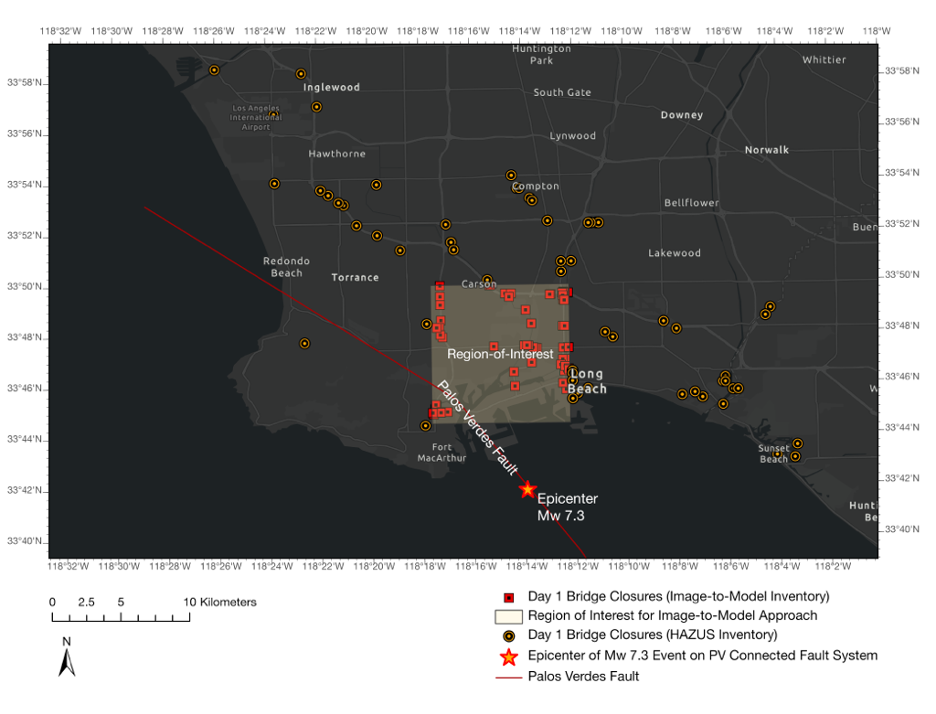 Map of the simulated earthquake and associated bridge closures.
Map of the simulated earthquake and associated bridge closures.
In his closing remarks, Soibelman emphasized the need for infrastructure assessment and repair, not only for safety concerns, but because of the added economic, social, and environmental impacts associated with infrastructure failure. We would like to extend our thanks to Dr. Lucio Soibelman for his participation in our seminar series, and for reminding us all of the timeliness of resiliency and disaster planning.
If you would like to watch the full video of the event or event highlights, or access the presentation slides, please click here.
About the Author:
Hayley Rundle is a first-year Master of Urban Planning student at the USC Price School of Public Policy, concentrating in Mobility and Transportation Planning. She is interested in sustainable transportation planning to improve environmental quality, equity, and mobility for all. Hayley serves as the team leader for the METRANS Industry Engagement and contributes to the Student Research Team, summarizing cutting edge transportation research projects and findings for the upcoming METRANS Fast Facts for Students series.
News Archive
- December (1)
- November (6)
- October (4)
- September (2)
- August (3)
- July (4)
- June (3)
- May (7)
- April (8)
- March (11)
- February (8)
- January (7)
- December (7)
- November (8)
- October (11)
- September (11)
- August (4)
- July (10)
- June (9)
- May (2)
- April (12)
- March (8)
- February (7)
- January (11)
- December (11)
- November (5)
- October (16)
- September (7)
- August (5)
- July (13)
- June (5)
- May (5)
- April (7)
- March (5)
- February (3)
- January (4)
- December (4)
- November (5)
- October (5)
- September (4)
- August (4)
- July (6)
- June (8)
- May (4)
- April (6)
- March (6)
- February (7)
- January (7)
- December (8)
- November (8)
- October (8)
- September (15)
- August (5)
- July (6)
- June (7)
- May (5)
- April (8)
- March (7)
- February (10)
- January (12)















